Introduction
In today’s privacy-focused digital landscape, businesses must balance user privacy and data collection. Google’s Advanced Consent Mode is a cutting-edge framework that enables website owners to respect user consent preferences while maintaining critical insights for business optimization. This article delves into the nuances of Google Consent Mode, exploring its features, implementation, and benefits for compliance with privacy regulations, including a comparison between the Basic and Advanced Google Consent Mode v2.
Definition and Purpose of Google Consent Mode
Google Consent Mode is a powerful solution designed to align businesses with data privacy laws such as the General Data Protection Regulation (GDPR) and ePrivacy Directive. It allows websites to adjust how Google services like Google Ads and Google Analytics collect and process user data based on consent preferences.
The implemented consent mode impacts data collection and Google Ads performance by differentiating between Basic and Advanced Consent Modes, affecting data transmission, consent management, and marketing campaign optimization.
By implementing Google Consent Mode, businesses can:
Respect user consent choices regarding cookies and trackers.
Ensure compliance with stringent data protection laws.
Collect vital data through consent modeling while maintaining user trust.
This framework offers a customizable approach for website owners, enhancing both compliance and website performance.
How Google Consent Mode Works
Google Consent Mode bridges the gap between respecting user privacy and gathering valuable data insights. It dynamically adjusts the behavior of Google tags based on the user’s consent status, which is determined through the consent banner on a website. The consent mode API further enhances this by dynamically adjusting the behavior of Google tags, allowing for more nuanced conversion modeling and greater customization.
Consent Banner Integration: When a consent banner appears, users can grant or deny consent for data collection.
Tag Behavior Adjustment: Google tags load or restrict based on the user’s consent status. For unconsented users, cookieless pings ensure aggregate, non-identifiable data is collected.
Conversion Modeling: To address gaps caused by denied consent, conversion modeling estimates performance data, aiding businesses in optimizing campaigns without violating privacy.
Understanding Basic and Advanced Consent Modes
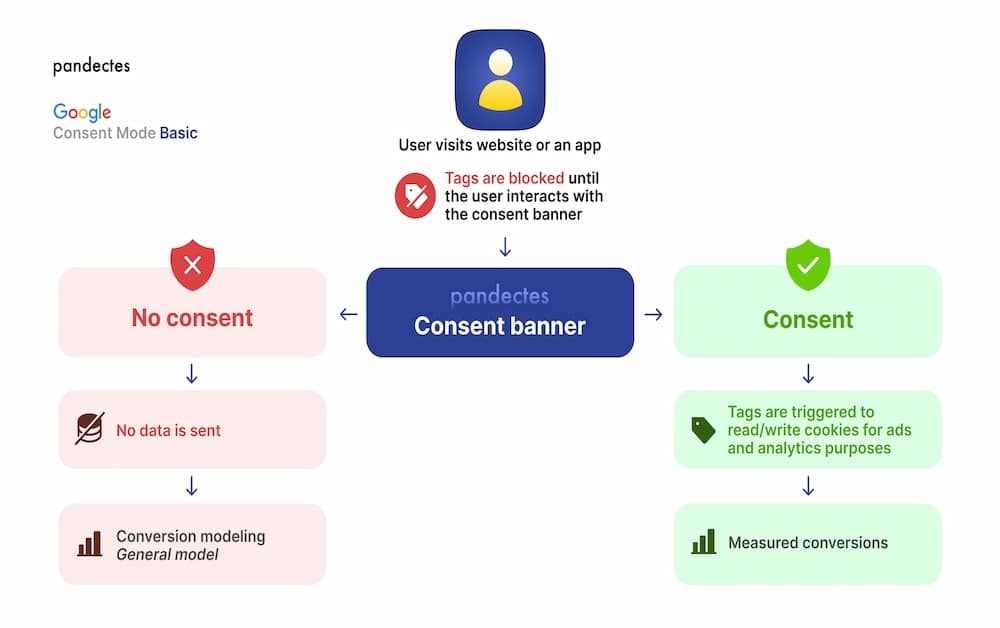
What is Basic Consent Mode?
Basic Consent Mode offers a simplified approach for website owners with limited technical expertise. This mode:
Blocks Google tags by default until the user grants consent.
Relies on basic data modeling to ensure minimal disruptions to data collection.
For website owners seeking ease of use, Basic Consent Mode provides essential compliance without complex configurations.
Key Differences Between Basic and Advanced Consent Modes
While the Basic Consent Mode is straightforward, the Advanced Consent Mode offers enhanced customization and control. Key distinctions include:
Customization: Advanced Consent Mode allows website owners to define specific tag behaviors and consent parameters.
Tag Loading: In Advanced Mode, Google tags load before the consent banner collects user preferences, enabling seamless data handling for both consenting and non-consenting users. The consent mode APIs function differently in Basic and Advanced Consent Modes, as they allow tags to load and send consent states only after a user has granted consent, ensuring precise data transmission based on user interactions.
Data Modeling: Advanced Mode supports conversion modeling with greater precision, preserving insights while respecting privacy.
Advanced Consent Mode Features
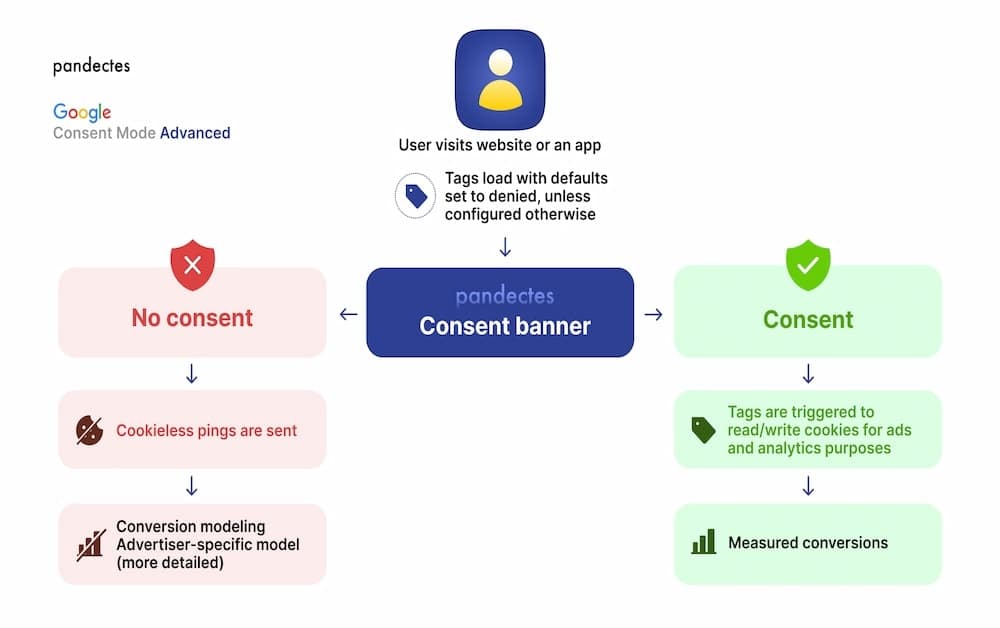
What are Cookieless Pings?
Cookieless pings are integral to Advanced Consent Mode, enabling data collection without cookies for unconsented users. These pings:
Transmit aggregated, non-identifiable data about user interactions.
Support privacy-friendly analytics and conversion modeling.
Allow businesses to maintain some level of data-driven decision-making, even when users deny consent.
How Advanced Consent Mode Handles User Consent Preferences
Advanced Consent Mode empowers businesses to customize consent interactions and enhance user trust. This includes:
Tailored Consent Messages: Implement multiple messages for various data categories, such as analytics and marketing cookies.
Consent Management: Integrate with a Consent Management Platform (CMP) to streamline consent collection and processing.
Respect for User Choices: Ensure all data handling aligns with user preferences, fostering transparency and trust.
How Advanced Consent Mode Modeling Works
Advanced Consent Mode modeling leverages sophisticated machine learning algorithms to estimate conversion data from users who have not granted consent for tracking. Consent mode’s conversion modeling uses these algorithms to provide accurate conversion estimates under both Basic and Advanced Consent Modes. This innovative feature allows businesses to gain insights into the effectiveness of their ads without compromising user privacy. By analyzing various factors such as user behavior, device type, and location, the modeling process can accurately predict the likelihood of conversions. This data-driven approach provides a comprehensive view of marketing performance, enabling businesses to optimize their campaigns and make informed decisions.
Compliance and Regulatory Requirements
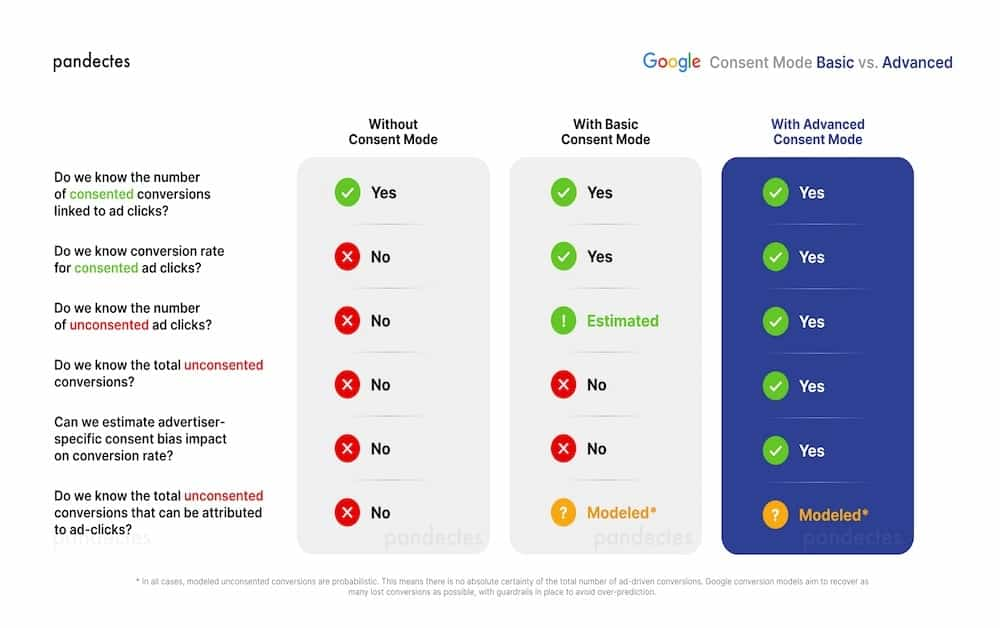
Is Advanced Consent Mode Compliant with Regulations?
Advanced Consent Mode is designed to comply with global privacy standards, including GDPR, ePrivacy Directive, and the Digital Markets Act. The user’s consent status enables website owners to customize the behavior of tags and cookies based on various consent states. Its regulatory alignment depends on proper implementation, so businesses should:
Work with a legal team or Data Protection Officer (DPO) to validate compliance.
Regularly review and adapt practices to meet evolving regulations.
Latest Requirements for Google Consent Mode V2
Starting in March 2024, Google Consent Mode V2 introduces stricter requirements:
Mandatory CMP Integration: Websites must use a Google-certified CMP to manage user consent.
Enhanced Tracking Limitations: Features like remarketing and conversion tracking in the European Economic Area (EEA) will be restricted without Consent Mode implementation.
Compliance Checklists: Businesses must adhere to Google’s updated guidelines to maintain access to critical features.
Benefits of Implementing Advanced Consent Mode
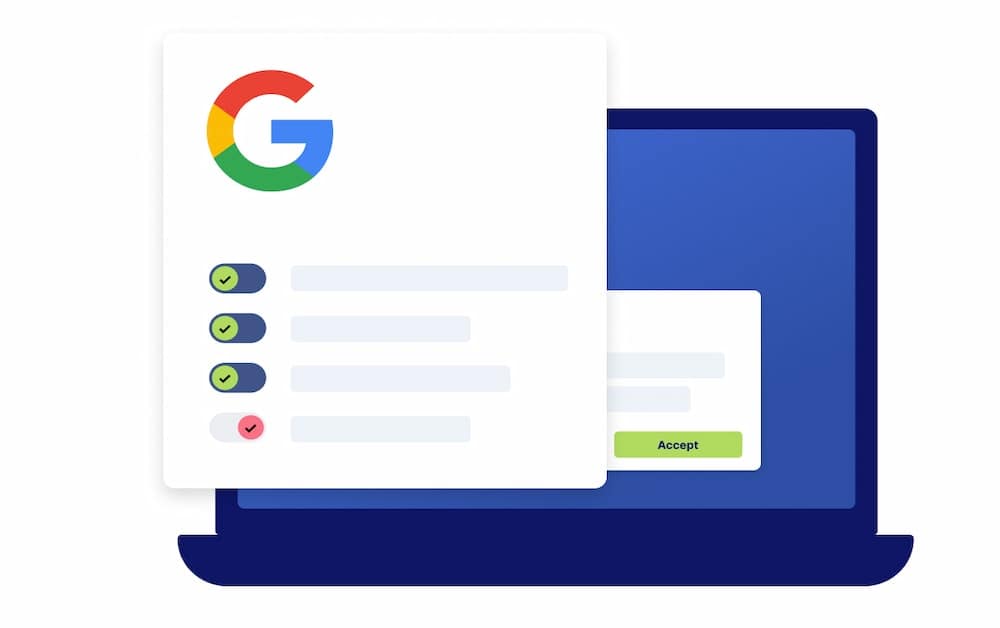
Accurate Conversion Tracking
Advanced Consent Mode minimizes data loss from unconsented users through:
Conversion Modeling: Machine learning estimates conversion data, offering a more comprehensive view of performance. User’s consent impacts the functionality of Google Tags by determining how conversion data is collected and modeled, ensuring compliance with privacy preferences.
Campaign Insights: Accurate tracking helps optimize marketing efforts without infringing on user privacy.
Enhanced User Trust
Offering clear and customizable consent options builds user trust. Businesses can:
Demonstrate a commitment to privacy through transparency.
Enhance long-term customer relationships by respecting user choices.
Flexibility and Control Over User Data
One of the standout features of Advanced Consent Mode is the unparalleled flexibility and control it offers over user data. Businesses can define specific behaviors for tags and cookies based on the user’s consent status, ensuring that data collection is both compliant and respectful of user privacy. This means that data from consenting users can be collected and utilized while the privacy of non-consenting users is safeguarded. Additionally, Advanced Consent Mode supports the implementation of multiple consent messages tailored to different types of cookies and tracking technologies, empowering users to make informed choices about their data privacy preferences.
Better Ad Campaign Performance
Advanced Consent Mode supports robust ad performance analysis by:
Allowing businesses to evaluate campaign effectiveness despite consent restrictions.
Enabling data-driven decisions to improve return on investment (ROI).
Implementation and Setup

How to Set Up Google Consent Mode V2
Proper setup requires collaboration between marketing and technical teams:
Select a CMP: Choose a Google-certified CMP for seamless integration.
Technical Implementation: Work with web developers to integrate Consent Mode into your website using Google Tag Manager and analytics tools.
Verification: Use tools like Google Tag Assistant or Google Ads Conversion Summary to confirm functionality.
Best Practices for Implementing Advanced Consent Mode
Maximize the benefits of Advanced Consent Mode with these practices:
Use a CMP: Ensure it is Google-certified to guarantee compliance. Managing user consent through a CMP ensures compliance with privacy regulations.
Regular Audits: Periodically review consent handling to adapt to new regulations and user expectations.
Transparent Messaging: Create clear consent banners to enhance user understanding and decision-making.
Using a Consent Management Platform (CMP)

What is a CMP?
A Consent Management Platform is essential for managing user consent effectively. CMPs:
Collect, store, and manage consent data.
Integrate seamlessly with Google services to streamline consent processes.
Benefits of Google-Certified CMPs
Using a certified CMP ensures:
Reliable integration with Google Consent Mode.
Compliance with privacy regulations through robust features.
Simplified implementation of consent banners and related functionalities.
Preserving Marketing Efforts with Consent Mode

How to Preserve and Enhance Marketing Efforts
Consent Mode supports marketing efforts by:
Allowing data collection from consenting users to model trends.
Enabling businesses to gather valuable insights while adhering to privacy-first principles.
Ensuring that data transmission to Google only occurs after user interaction with a consent banner, preventing Google tags from loading until consent is granted.
What Happens if You Don’t Implement Consent Mode?
Without Consent Mode:
Access to audience functionalities for EEA users is restricted.
Businesses lose critical insights, impacting optimization and ROI.
Choosing the Right CMP Partner
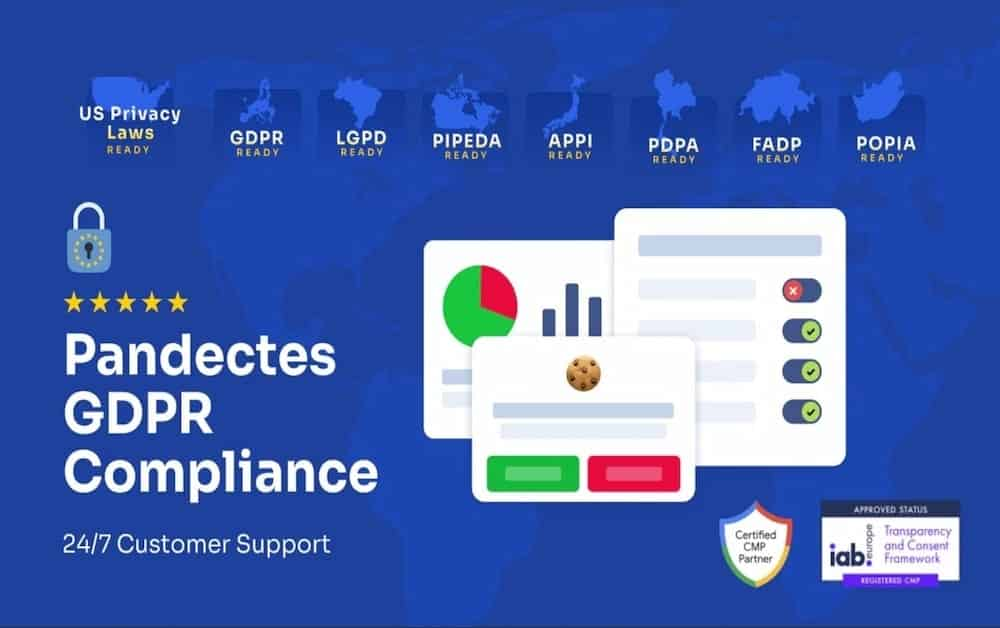
Why Choose a Google-Certified CMP Partner?
Opting for a Google-certified CMP partner is essential for businesses looking to implement and manage Consent Mode efficiently. Certified CMPs, like Pandectes GDPR Compliance, provide:
Seamless integration and setup of Consent Mode: Ensures Google Consent Mode is properly implemented, reducing technical hurdles for website owners.
Ongoing compliance with privacy regulations: Helps your business stay compliant with evolving data privacy laws like GDPR, CCPA, and others.
Expert guidance in navigating consent management complexities: Offers specialized knowledge to handle consent preferences and data protection requirements with ease.
Benefits of Partnering with a CMP Expert
Working with a CMP expert, such as Pandectes GDPR Compliance, delivers numerous advantages:
Simplified implementation of Consent Mode: With Pandectes, Shopify store owners can quickly and efficiently manage cookie consent and script blocking without extensive technical knowledge.
Tailored solutions to meet business and regulatory needs: Pandectes provides customizable features to address unique website and user data requirements.
Accurate handling of user data and consent: The platform ensures all user interactions are processed in line with compliance standards, offering peace of mind and improved trust with users.
Pandectes GDPR Compliance stands out as the top CMP solution for Shopify users, offering a robust and user-friendly approach to managing consent and ensuring compliance. Learn more at Pandectes GDPR Compliance or on the Pandectes app page.
Expert Insights
Implementing Advanced Consent Mode requires a nuanced understanding of user consent preferences and data privacy laws. Experts in the field highlight that “Advanced Consent Mode is a game-changer for businesses that want to respect user privacy while still collecting valuable data insights.” By offering flexibility and control over user data, Advanced Consent Mode helps businesses build trust with their users and demonstrate a commitment to ethical data practices. This approach not only ensures compliance with regulations but also fosters a transparent relationship with users.
Expert Tips for Implementation
Use a Consent Management Platform (CMP): A CMP is essential for managing user consent seamlessly and implementing Advanced Consent Mode on your website or app.
Define Specific Behaviors for Tags and Cookies: Leverage Advanced Consent Mode to set specific behaviors for tags and cookies based on user consent states, ensuring compliance and respect for user privacy.
Implement Multiple Consent Messages: Tailor multiple consent messages to different types of cookies and tracking technologies, giving users greater control over their data privacy preferences.
Monitor and Adjust: Regularly monitor your implementation and make necessary adjustments to ensure that you are respecting user privacy while collecting valuable data insights.
By following these expert tips, businesses can effectively implement Advanced Consent Mode, manage user consent, and comply with evolving data privacy laws.
Conclusion
Google’s Advanced Consent Mode is a game-changer for businesses aiming to balance data-driven decisions with compliance and user privacy. Its robust features, seamless integration, and compliance capabilities make it an indispensable tool for modern website owners. By implementing Consent Mode, businesses can unlock valuable insights, maintain user trust, and ensure adherence to evolving privacy regulations.



